Meet our fish species
The experience at the Interactive Aquarium Cancun begins with observing our diverse variety of fish species, from both freshwater and saltwater. The fish exhibits area has more than 1,500 specimens from approximately 120 different species. Here are some of them including some species native Cancun.
More about our species
Alligator gar

Alligator gar
Atractosteus spatula
They are fish with a grayish green to brown dorsal surface and yellow or white ventral side. They can also have brown spots on their dorsal surface. They have an alligator-like appearance, with long, slender bodies protected by thick scales, jaws armed with many teeth, and a habit of floating on the water's surface. Their snout is short and wide with two rows of teeth in the upper jaw.
- Distribution: North America and Gulf of Mexico
- Diet: Fish, ducks, birds and small mammals
- Size: They can reach up to 3 m in length
- Conservation status: Least concern
Did you know that?
The alligator gar has the ability to breathe outside of water. This is accomplished thanks to its swim bladder which is covered in many capillaries that help it breathe air from the atmosphere.
Atlantic tarpon

Atlantic tarpon
Megalops atlanticus
These long fish have a slightly upward-pointing mouth and soft, lobed fins. From above they appear dark blue or greenish black, or even coppery if they've been in freshwater, but are recognizable by their very shiny silvery sides covered in large scales. They live in mangrove bays and lagoons and can swim upstream into freshwater.
- Distribution: Atlantic Ocean. Widely distributed in the Caribbean and Gulf of Mexico to Brazil
- Diet: Fish and crustaceans
- Size: They can reach up to 2.5 m in length
- Conservation status: Vulnerable
Did you know that?
Tarpons have a modified swim bladder that allows them to live in low oxygen environments. The alveolar tissue of the swim bladder and a duct connecting the swim bladder to the esophagus allow the tarpon to breathe air from the atmosphere.
Brazilian cocoa damselfish
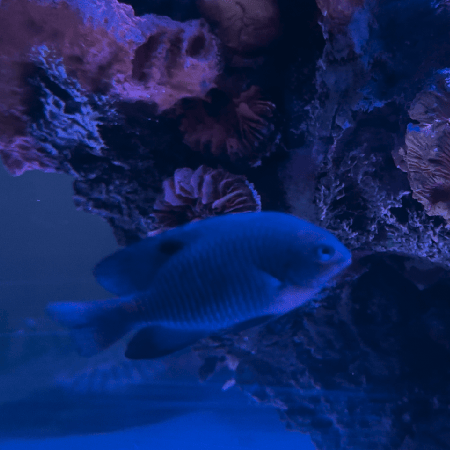
Brazilian cocoa damselfish
Stegastes variabilis
These fish have a dark brown, bluish color on the dorsal side, that becomes yellow in the ventral region as they grow. Bright blue lines adorn the mouth and the front of the head. A small dark spot is noticeable in the end of the pectoral fin, and another above the caudal peduncle. They inhabit coastal and marine coral reefs, and the juveniles are aggressive and territorial.
- Distribution: Western Atlantic - Brazil and the Caribbean
- Diet: Algae and sponges
- Size: They can reach up to 12.5 cm in length
- Conservation status: Least concern
Colombian shark catfish

Colombian shark catfish
Ariopsis seemanni
It is a metallic gray fish with white edges on the fins, featuring an erect dorsal fin from which its name shark is derived. It inhabits estuaries and does not exhibit sexual dimorphism, however, the males are more elongated than the females.
- Distribution: Pacific coast of Central America and the northeastern tip of South America
- Diet: Shrimp, prawns, worms and mussels
- Size: They can reach up to 44 cm in length
- Conservation status: Least concern
Did you know that?
The sexually mature female has a more swollen belly than the male.
Eyed flounder
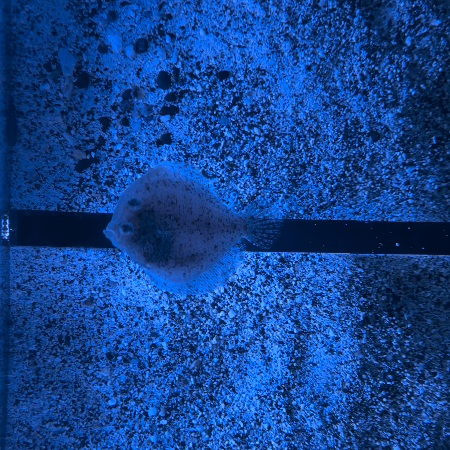
Eyed flounder
Bothus ocellatus
A flatfish that spends most of its time on the seabed, changing its color to match the surrounding area.It inhabits sandy coral or seagrass areas, usually near reef patches. It is found in shallow coastal waters at depths of up to 110m. It spends its time lying motionless on the bottom, moving only when frightened.
- Distribution: Western Atlantic and Gulf of Mexico to southern Brazil
- Diet: Fish, shrimp and crab
- Size: They can reach up to 18 cm in length
- Conservation status: Least concern
Did you know that?
These fish are born with an eye on each side of the head like any other fish, however, as they grow, their right eye migrates to the left side causing both eyes to be on the same plane.
French angelfish

French angelfish
Pomacanthus paru
The appearance of the French angelfish is significantly different between juveniles and adults. Juveniles are dark brown to black with thick, curved yellow bands on the head and body. when they reach adulthood, the yellow bands fade except for a yellow bar at the outer base of the pectoral fin. The scales turn black with yellow edges, and the face becomes light blue with a white chin and mouth.
- Distribution: Western Atlantic - from Florida, USA, and the Bahamas to Brazil, including the Gulf of Mexico and the Caribbean
- Diet: Sponges and algae
- Size: They can reach up to 41 cm in length
- Conservation status: Least concern
Giant gourami
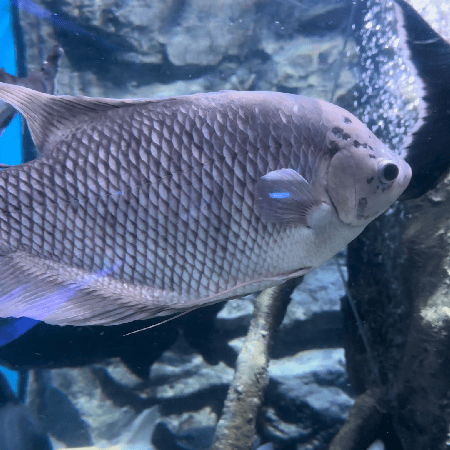
Giant gourami
Osphronemus goramy
It is mostly found at depths ranging from 0 to 10 m. It lives in swamps and rivers, near large roots, which it uses for refuge when facing danger. Males have a pointed dorsal and anal fin.
- Distribution: Asia
- Diet: Herbivore
- Size: They can reach up to 70 cm in length
- Conservation status: Least concern
Did you know that?
Gouramis have the ability to breathe in two different ways. In addition to gills, this species is equipped with a breathing apparatus called the labyrinth organ that allows it to absorb oxygen from the air.
Giraffe hap

Giraffe hap
Nimbochromis venustus
This fish gets its name from its colorful appearance with cloud-like spots: Nimbochromis comes from the Latin words "nimbo," meaning "clouds or rainy," and "chromis," meaning colorful, both unique features on its genus. In other countries, it is also known as the commando fish due to its camouflage-like appearance. The sexes are primarily distinguished by color: the female doesn't develop as much color as the male, lacks the blue color on the face, and appears more subdued.
- Distribution: Africa - endemic to Lake Malawi
- Diet: Fish and invertebrates
- Size: They can reach up to 25 cm in length
- Conservation status: Least concern
Did you know that?
During reproduction, the female cares for the offspring by carrying them in her mouth.
Gray angelfish

Gray angelfish
Pomacanthus arcuatus
Adult gray angelfish have light gray scales over most of the body with darker blue-gray scales scattered throughout. The chin area is a white or smoky gray with white around the mouth. Their eye, lips and fins sometimes have a narrow rim of bright blue. Their pectoral fins can also have yellow details.
- Distribution: Western Atlantic to Brazil, including the Gulf of Mexico and the Caribbean
- Diet: Algae, sponges and sea grasses
- Size: They can reach up to 60 cm in length
- Conservation status: Least concern
Iridescent shark catfish

Iridescent shark
Pangasianodon hypophthalmus
This catfish gets its name from its juvenile coloration, a silvery iridescence with a pair of dark stripes and a body shape resembling that of a shark. As they reach adulthood, their coloration turns into a uniform darker gray and they lose the stripes. It is one of the most significant aquaculture species in Thailand.
- Distribution: Asia
- Diet: Fish, crustaceans and algae
- Size: They can reach up to 1.3 m in length
- Conservation status: Endangered
Did you know that?
In some areas, this fish has become an invasive species due to its introduction because of aquaculture.
Japan surgeonfish

Japan surgeonfish
Acanthurus japonicus
They have a brown body with a white spot on the cheek between the mouth and eyes. The pectoral, anal, and dorsal fins are dark brown with light blue highlights on the edge. They have an orange stripe on the dorsal and a blue with a yellow line on their dorsal fin. A yellow band runs along the whole body, up the anal and dorsal fins, forming a triangle-shaped mark.
- Distribution: From the Indo-Pacific to the Philippines
- Diet: Algae
- Size: They can reach up to 21 cm in length
- Conservation status: Least concern
Did you know that?
This species has a sharp spine at the base of its caudal fin. These scalpel-like spines are a natural form of defense. They are only visible when the fish feels threatened.
Lionfish

Lionfish
Pterois volitans
This reef fish has become an invasive species in the western Atlantic where it has few or no predators. Lionfish are covered in brown and white stripes, with long fins and venomous spines. It lives near rocky coral areas where they can hunt small fish and invertebrates and then retreat into crevices.
- Distribution: Indo-Pacific
- Diet: Fish and crustaceans
- Size: They can reach up to 45.7 cm in length
- Conservation status: Least concern
Did you know that?
The lionfish is a venomous fish. The sting from is not lethal to humans, but the pain can last for days and cause symptoms like sweating and breathing problems. The commercially available stonefish antivenom has some detoxifying effect on lionfish venom.
Orange clownfish

Orange clownfish
Amphiprion percula
This fish can be distinguished by its three white vertical bars on an orange body. A black border of variable thickness outlines each fin and the white parts. Despite the bright colors, it is easy to mistake it for the false clownfish. You can tell these two apart by the number of spines in the dorsal fin. A. percula typically has 10 spines in the dorsal fin, while A. ocellaris usually has 11. But also, the latter never has black margins outlining the fins.
- Distribution: Indo-Pacific
- Diet: Zooplankton and algae
- Size: They can reach up to 11 cm in length
- Conservation status: Least concern
Did you know that?
The clownfish can live within anemones without being stung thanks to a mucous layer they secrete on their bodies to protect themselves from the anemone's venom.
Orange-lined triggerfish

Orange-lined triggerfish
Balistapus undulatus
These fish have a first dorsal spine in the first dorsal fin that can be fixed in place. The main body color ranges from green to brown, featuring diagonal curved orange lines, as well as narrow orange and blue stripes extending from the mouth to beneath the pectoral fins. The caudal fin is orange-yellow, and they exhibit a black area around the caudal peduncle. Distribution: Indo-Pacific.
- Distribution: Indo-Pacific
- Diet: Algae, fish, mollusks, and sponges
- Size: They can reach up to 30 cm in length
- Conservation status: Least concern
Pirapitinga
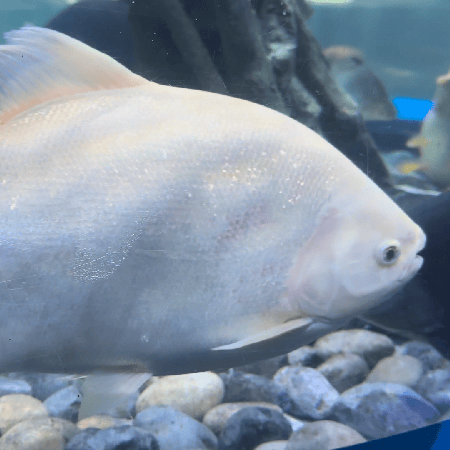
Pirapitinga
Piaractus brachypomus
It features a laterally compressed body, with silvery sides (which darken towards the back) and red coloring on the belly, chin, pectoral fins, and occasionally the main rays of the anal fin. Although not as well-developed or sharp as those of piranhas, red-bellied or Pirapitinga pacu have two rows of hard, flattened teeth that they use for crushing.
- Distribution: Amazon and Orinoco rivers basins
- Diet: Fish, crustaceans, and seeds
- Size: They can reach up to 88 cm in length
- Conservation status: Least concern
Did you know that?
When young, red-bellied or Pirapitinga pacus mimic piranhas by displaying dark gray to black spots on their bodies, a standard feature of piranhas. This protects them against predators.
Planehead filefish

Planehead filefish
Stephanolepis hispida
This fish has a compressed body with a beige or yellow-green color and darker spots. The fins have either white or yellow hues and the bases of the dorsal and anal fins are dark. Their skin is thick and rough. The caudal fin is rounded, while the dorsal fin is divided into two by a concavity, creating a sail-like or antenna-like appearance with the first two rays.
- Distribution: Western Atlantic from Nova Scotia, Gulf of Mexico, and the Caribbean, along the South American coast to Uruguay
- Diet: Invertebrates
- Size: They can reach up to 37 cm in length
- Conservation status: Least concern
Queen angelfish
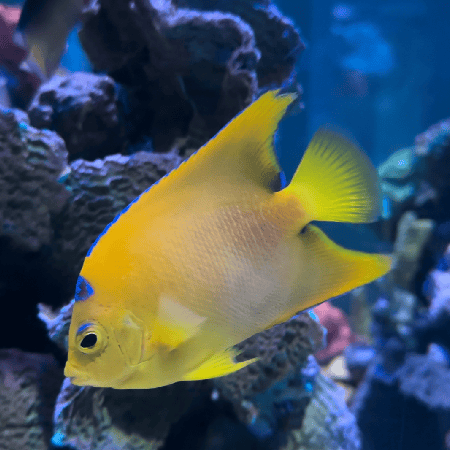
Queen angelfish
Holacanthus ciliaris
The queen angelfish can be easily distinguished by its striking colors, featuring vibrant yellows and a variety of blue hues. Its distinctive "crown" is speckled dark blue and surrounded by a ring of bright blue. Their tail is completely yellow. Juveniles have a remarkably different coloration from adults, with either a pattern of blue and yellow stripes or a solid yellow pattern. They can be found at depths of up to 70 meters. Although marine by nature, they can tolerate changes in salinity.
- Distribution: Florida, United States, and the Gulf of Mexico to Brazil
- Diet: Sponges, coral polyps, and marine algae
- Size: They can reach up to 45 cm in length
- Conservation status: Least concern
Spot-fin porcupinefish

Spot-fin porcupinefish
Diodon hystrix
A round-bodied fish with small fins. It lacks pelvic fins and the dorsal and anal fins are close to the caudal fin. They are covered in long spines, which lay flat against its body when not inflated. Their body color is generally a dull brown or green color with the small dark spots and marks throughout their body. These fish have large eyes and wide and flattened mouth with fused teeth and very strong jaws.
- Distribution: Tropical oceans: Indo-Pacific, Western Atlantic, and northern Gulf of Mexico to Brazil
- Diet: Sea urchins and hermit crabs
- Size: They can reach up to 91 cm in length
- Conservation status: Least concern
Did you know that?
Its whole body is covered in spines to defend against predators and it is poisonous for humans to eat.
Spotbanded scat

Spotbanded scat
Selenotoca multifasciata
This fish displays a two-tone coloration with a silver and black body, featuring vertical black stripes. As it grows, it will lose the stripes as they are replaced by dots. They are found at depths of up to 5 meters.
- Distribution: Indo-Pacific
- Diet: Algae and small crustaceans
- Size: They can reach up to 40 cm in length
- Conservation status: Least concern
Did you know that?
The spotbanded scat has pointed dorsal fins that contain a small amount of poisonous toxins.
Spotted moray eel

Spotted moray eel
Gymnothorax moringa
This fish is often found hidden among rocks due to its limited swimming ability. Having the need to pull food toward its throat instead of creating suction through its mouth, it has an additional pair of jaws in the throat to pull the food into the stomach. This second pair of jaws, which are attached to the esophagus, grabs the prey and drags it into the throat as, the first pair of jaws releases the prey, allowing it to be consumed.
- Distribution: Western Atlantic - from North Carolina, USA, and Bermuda to Brazil, including the Gulf of Mexico, the Caribbean, and southeast Brazil
- Diet: Fish and crustaceans
- Size: They can reach up to 2 m in length
- Conservation status: Least concern
Spotted scat

Spotted scat
Scatophagus argus
A rectangular shaped fish with a green color base, with rounded green or black spots on both sides of its body; the spots are more visible in young specimens than in adults and as they complete their growth the spots are oriented more towards the top of the body. The head is small compared to the rest of their laterally compressed body.
- Distribution: Indo-Pacific
- Diet: Algae and small crustaceans
- Size: They can reach up to 45 cm in length
- Conservation status: Least concern
Did you know that?
It is a venomous fish. The dorsal fins contain a small amount of venomous toxins.
Spotted scorpionfish

Spotted scorpionfish
Scorpaena plumieri
The "scorpion fish" or "stone fish" gets its name from its venomous dorsal, anal, and pelvic spines, which contain a toxic protein. They remain motionless for most of the day and become active at night. The color patterns on their bodies blend well with their surroundings, providing them with the camouflage to go unnoticed by their prey. Their coloration is highly variable, usually a mix of brownish hues, speckled with gray, brown, red, and black.
- Distribution: Western Atlantic - from Bermuda, Massachusetts, and the northern Gulf of Mexico to southern Brazil
- Diet: Fish and crustaceans
- Size: They can reach up to 45 cm in length
- Conservation status: Least concern
Did you know that?
The stone fish is a close relative of the lionfish. They both belong to the Scorpaenidae family, sharing the common trait of venomous spines.
Southern stingray
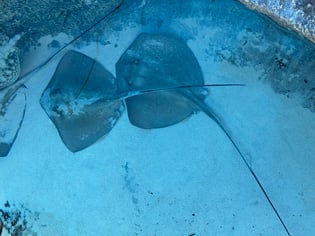
Southern stingray
Hypanus americanus
Diamond-shaped ray with olive brown to greenish grey coloration on the top and a white underside. Its pectoral fins can grow up to 2 meters, it can use them to stir up the sandy ocean floor to find crustaceans and small fish, or to bury itself to hide from predators or to ambush prey.
- Distribution: Western Atlantic and northern Gulf of Mexico to Brazil
- Diet: Fish and crustaceans
- Size: They can reach up to 2 m in length
- Conservation status: Near threatened
Did you know that?
Stingrays are ovoviviparous: it produces offspring by means of eggs that are hatched inside the female's body. This means the offspring are protected by the mother as they develop inside her body. During early development, the embryo utilizes a yolk sac for nutrition.
Threespot dascyllus domino damsel

Threespot dascyllus domino damsel
Dascyllus trimaculatus
When these fish are juveniles they have white spots on their foreheads and sides. As they mature, these spots usually disappear, or sometimes they end up with a permanent spot on their sides. Their body is oval shaped, almost round, and deep gray-blue in color.
- Distribution: Indo-Pacific
- Diet: Algae and crustaceans
- Size: They can reach up to 14 cm in length
- Conservation status: Least concern
Did you know that?
During their reproduction cycle, it's the males who take care of the offspring.
White grunt

White grunt
Haemulon plumieri
This fish has a yellow color, with dark-outlined blue lines on the head. The body scales are bicolored, blue and yellow, creating a distinctive pattern. The inside of the mouth is red. This species exhibits an intriguing territorial behavior known as "kissing": they position themselves facing each other, open their jaws, and gently tap each other.
- Distribution: Western Atlantic, Gulf of Mexico, and the Caribbean
- Diet: Crustaceans, small mollusks, and fish
- Size: They can reach up to 53 cm in length
- Conservation status: Least concern
Did you know that?
These fish produce a grunting sound by rubbing their teeth together, creating a noise similar to a grunt.
Yellowfin surgeonfish

Yellowfin surgeonfish
Acanthurus xanthopterus
A fish with a laterally compressed, oval body and a small mouth located on the underside of the head. They have a purple-gray coloration with a yellow spot around the eyes and mouth. The tips of their pectoral fins are also yellow while the caudal fin is bluish and often features a white bar at the base. They can take on a very pale gray coloration, with numerous darker wavy lines along the sides of the body.
- Distribution: Indo-Pacific
- Diet: Diatoms, filamentous algae, and fish
- Size: They can reach up to 70 cm in length
- Conservation status: Least concern
Did you know that?
The name surgeonfish comes from the sharp, venomous scalpel-like spines they have at the base of the caudal fin.

